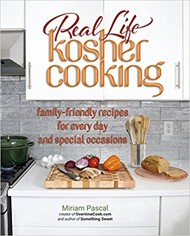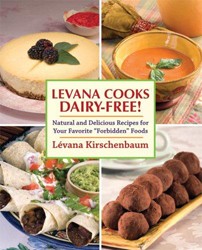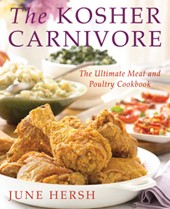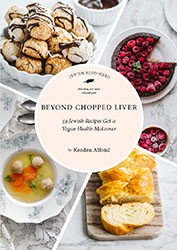Helen Nash has long maintained that “kosher food is more than chopped liver and gefilte fish,” and in her latest book she once again demonstrates her ability to expand the kosher palate. Taking advantage of newly kosher ingredients — wasabi, truffle and sesame oils, miso, panko crumbs — she introduces an array of dishes that mingle the flavors of the Mediterranean and Asia with good everyday cooking.
Nash takes easily available ingredients, straightforward techniques, and a dash of long-earned culinary knowledge to create dishes that are simple to prepare, fresh, and flavorful. Tuna tartare or a soft green soup of peas and zucchini makes a light and lovely appetizer to a spring meal. Follow with Arctic char with honey and wasabi or marinated salmon with mango-kiwi relish and a side of sweet and sour acorn squash. Desserts range from a traditional honey cake to pear clafouti and apricot soufflé.
All of Nash’s recipes are conceived with nutrition in mind but no diminution of flavor. Challenged by her husband’s long illness and health requirements, she has turned to well-seasoned vegetables, grains, fish, and poultry for many meals, but she includes traditional favorites like cabbage and mushroom soup, gefilte fish with homemade challah and horseradish, pot roast, and cholent. Like any experienced cook, Nash is a source of helpful pointers in the recipes as well as a brief section of tips, list of ingredients, and notes on techniques and equipment. Handsomely illustrated with full-color photographs (seen only in black and white by the reviewer), Nash’s book is a worthy addition to the kitchen library for both practical and healthful everyday cooking and easy to prepare meals for entertaining and holidays. Illustrations, index, notes.
Interview
Healthy, simple, and stylish — the subtitle of Helen Nash’s third cookbook clearly announce her approach and the recipes she has developed over the past several years. In a lively and wide-ranging conversation, Nash talked about her new book and the place that cooking has had in her life.
Helen Nash: The reason for this book was my husband’s illness, so it was both hard and easy to write — hard because of his illness and how it changed our lives and easy because I had been cooking for fifty-four years. The core of the book is my life experience with my husband.
There was no cooking in my childhood. When I was four and a half, my family was transported out of Krakow, and we spent the war in labor camps in Siberia. Food was nonexistent — no fruit, no vegetables. It was a a ration diet of subsistence level.
My discovery of food was gradual. My mother didn’t know how to cook. In Poland my family was prosperous and had help. My mother worked in the family business.
Maron L. Waxman: So how did you develop your taste and talent for cooking?
HN: I married a man who loved food and who wasn’t kosher. I was young — twenty-one; I had just graduated from college — and came from a highly Orthodox home. He came from Berlin, from a not very observant family although he had never eaten shellfish or pork, and it was difficult for him to make the shift to kosher. He and his friends thought kosher food was chopped liver. But to me kosher wasn’t just food; it was a way of life. So we made a clear and tacit contract — we would have kosher food and a Jewish home, and that was fine with him as long as the food was good.
So my marriage was the catalyst. There was the joy of eating together, and it was the time when women were defined by the home they created and by how they parented. My children never ate anything from a jar. If you eat that way, you have no idea where the food comes from.
MLW: I’ve read that you’ve studied with some of the greatest cooking teachers. How did that come about?
HN: We moved to the suburbs because we thought children should be in the country. That lasted about a year and a half, and then we moved back to the city. The children were getting older, and I decided that I didn’t know anything about food, that I didn’t know the basics — for example, what the standards were to know what a good roast chicken is.
I began taking classes with Michael Field. Of course, I never ate any of his meat dishes. But he realized what my limitations were, and he wanted to help. He gave me substitutes and kept saying you can do this.
MLW, interrupting: I noticed a little similarity to Field’s chicken liver pate. You use some sherry, and I think he also added some brandy or something like that to his.
HN: Could be. He was a wonderful teacher. From there I moved on to Chinese cooking. A friend won cooking classes with Millie Chan at a school auction and gave them to me. I brought all my own food and got all the equipment — wok, steamer, cleaver. From Millie Chan I learned how to steam and stir-fry. I’m really committed to steaming and broiling rather than sauteeing. It is less caloric and it keeps the kitchen clean, and there’s no loss of taste.
MLW: Your recipe for Sake-steamed Chicken caught my eye. How did you learn about Asian flavorings like miso and wasabi?
HN: I read a lot and took notes. When flavorings like miso and wasabi became available in kosher versions, I experimented with them. They appealed to me. And my husband was very receptive to the new flavors. My guests liked them, too. No one ever complained. Baal teshuva particularly like those recipes, and they’re popular with nonkosher cooks, too.
MLW: So people used to traditional Jewish food responded favorably.
HN: They tasted the dishes, and they liked them. They are good on the palate.
But my real aim in this book was to make it easy for the woman with no time to run to the supermarket and buy twenty ingredients. Too many people are ordering in for dinner, and that’s not satisfying and it’s not good for children. This book is easier than my first two books, and I hope it will help. Most of the recipes have very few ingredients, and every ingredient is easily available. I was far more concerned with availability and simplicity than I was with my previous books. But you have to know ingredients. Quality ingredients are very important when simplicity is the basis. When I look at recipes now, I’m shocked by the amount of sugar and fat and the size of the portions. I don’t like the cloying sweetness in so many desserts. Why not do a simple clafouti? You can use any fruit. Or try a frittata. This is a book of everyday food, not holiday food.
And I’m also careful to indicate whether you can freeze the dishes. Freezing is wonderful, but you have to be careful to wrap everything well. With freezing you can prepare ahead, and you’ll always have soup ready for Friday night.
I’m also trying to overturn some myths about kosher food in this book. I’m not of the persuasion that Friday night has to be traditional. Sabbath doesn’t mean you have to have chicken or meat and potatoes. I often serve fish.
MLW: To change the subject a little, do your children cook?
HN: My son doesn’t cook often, but he knows how to use the right ingredients when he does. My daughter is a good cook, and she does cook for her family.
MLW: Given the ideas about marriage and home life, how did you come to write a book?
HN: My daughter went off to college, and the house felt a little empty-nesty. One night Jason Epstein [then an editor at Random House] came to dinner. He was the friend of a friend. I served something in puff pastry, and he didn’t even know it was made with margarine. When he found out, he said that if I ever wanted to write a kosher cookbook, he’d publish it, so I put together a proposal and that was the book. After that we became friends, and he did my second book, too.
This third book is a labor of love, in memory of my husband. I had a wonderful seasoned editor who wasn’t Jewish, so she asked a lot of questions. She was a real asset and helped clarify a lot of points.
But these recipes aren’t written in stone. People have to take some responsibility for their cooking. This is really a book about ideas and how to use them to make your own meals. In kosher cooking I hope we’ve moved a little away from our East European palate with its sour cream and pot cheese and farmer cheese — not that there aren’t traditional dishes in the book — and are cooking with new, fresh, lighter ingredients. That’s what this book is about.
Recipe: Seared Tuna with Tuna Sauces
Serves 6
Tuna is surely one of America’s favorite fish, and it lends itself to many types of preparation, from sashimi to “tuna-fish” sandwiches. The dish that follows calls for the fish to be almost raw; it can be accompanied with one of the Asian-inspired sauces, Ginger or Piquant Asian, that follow.
1 teaspoon kosher salt
2 teaspoons freshly ground black pepper
2 pounds (900 g) sashimi-quality tuna
1 tablespoon extra virgin olive oil
Julienned daikon, sliced seeded cucumbers, and strong-tasting salad
leaves like arugula or watercress, for garnish
Ginger Sauce or Piquant Asia Sauce, to serve
Combine salt and pepper in a small bowl.
Pat the tuna dry with paper towels. Heat the oil in a large nonstick skillet over medium heat. Sear the tuna on both sides, then remove from the heat and rub both sides with the salt-pepper mixture.
When cool, wrap the tuna tightly in wax paper, then in foil. Refrigerate it for at least 4 hours or overnight. This will make it firmer and thus easier to slice.
TO SERVE: Cut the fish against the grain in thin slices, and serve accompanied by the suggested vegetables. Serve either of the sauces separately.
From New Kosher Cuisine © 2012 Helen Nash. Published in 2012 by The Overlook Press. www.overlookpress.com. All rights reserved.
Maron L. Waxman, retired editorial director, special projects, at the American Museum of Natural History, was also an editorial director at HarperCollins and Book-of-the-Month Club.





